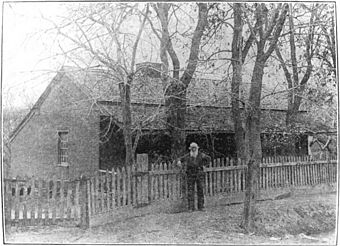John Steele House (Toquerville, Utah) facts for kids
Quick facts for kids |
|
|
John Steele House
|
|

Steele in front of the house c. 1900
|
|
| Location | 263 N. Toquerville Blvd., Toquerville, Utah |
|---|---|
| Area | less than one acre |
| Built | 1862 |
| Built by | John Steele |
| Architectural style | double cell |
| NRHP reference No. | 88000401 |
| Added to NRHP | April 7, 1988 |
The John Steele House is a special old home in Toquerville, Utah. It was built in 1862 by John Steele. He was one of the early Mormon pioneers who settled in the area. John Steele lived in this house until he passed away in 1903. He worked as a doctor who used plants for medicine. He also helped lead the town and county.
This house is unique because of its special layout, called a double-parlor style. It was added to the National Register of Historic Places in 1988. This means it's an important building because of its history and how it was built.
Contents
House Design and Features
This house has one story and sits on a stone base. Its walls are made of red adobe (a type of sun-dried brick). The roof is made of wood and has a gable shape, which means it slopes down on two sides. Most homes in Toquerville from this time were built with logs, not adobe. This makes the Steele House stand out.
Unique Floor Plan
The John Steele House is one of only a few homes in Utah with a double-parlor design. This means it has two main sitting rooms, or parlors. There is also a narrower hallway on the north side.
The house has an extra door compared to most double-parlor homes. This makes the front of the house look balanced. It almost looks like it has two rooms of the same size. The middle room, which has a large fireplace, was used as the kitchen.
Changes Over Time
In the 1860s or 1870s, a small lean-to (a simple addition) made of adobe was added to the back of the house. Later, in the 1930s, a larger lean-to made of wood was added to the other side of the back.
A porch that covered the whole front of the house was there in 1900, but it has since been removed. We don't know if this porch was part of the original design. The outside walls were probably covered with stucco (a type of plaster) and painted white in the early 1900s. Even with these changes, the inside of the house is almost exactly as it was. The original doors and windows are still there. This means the house still looks very much like it did when it was first built.
History of John Steele and His Home
Toquerville was founded just three years before John Steele moved there in 1861. He came from a nearby town called Parowan. He was part of the Mormons settling southern Utah. His family joined him in 1862.
John Steele knew how to make and lay adobe bricks. He had done this in Salt Lake City. Because of his skills, he likely built the house himself in 1862.
John Steele's Life and Work
John Steele was an important person in his community. He held many different jobs and roles:
- He was the postmaster in 1865.
- He served as a justice of the peace from 1868 to 1869.
- He was a surveyor in 1873.
- He worked as an assessor for Kane County from 1874 to 1875.
He also owned a boot and shoe shop nearby. He went on several missions for LDS Church. But many people knew him as "Doc" Steele. He was famous for setting broken bones and giving people herbal medicines. He also made horoscopes. Even when Utah started requiring medical licenses, he kept helping people until he passed away in 1903.
The John Steele House is still privately owned today. It was officially listed on the National Register of Historic Places on April 7, 1988. The people who nominated it said it was important because of its unique architecture and its history in the area. They noted that while there are about a dozen old houses in Toquerville, few are as old and well-preserved as the Steele House.


